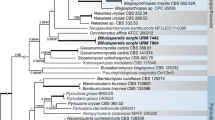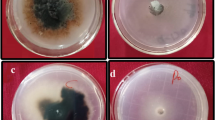Abstract
Setosphaeria monoceras, a teleomorph of Exserohilum monoceras, has been produced in culture through the crossing of compatible mating-type isolates from Japan. In this study, Sachs’ agar medium + maize leaf were placed at a constant temperature of 25°C with 16 h light and 8 h dark cycles for 25–30 days. When assessed, the morphological characteristics were almost identical to those of original description by Alcorn, using Australian isolates. This note presents the second report investigating the development of the perfect stage of E. monoceras.

Similar content being viewed by others
References
Alcorn JL (1978) Setosphaeria monoceras sp. nov., ascigeneous state of Exserohilum monoceras. Mycotaxon 7:411–414
Chang HS, Fan KC (1986) Comparative studies on some biology and pathology of corn and broom corn isolates of Exserohilum turcicum (Pass) Leonard and Suggs. Bot Bull Acad Sin (Taipei) 27:209–218
Dyer PS, Ingram DS, Johnstone K (1992) The control of sexual morphogenesis in the Ascomycotina. Biol Rev 67:421–458
Izumitsu K, Yoshimi A, Kubo D, Morita A, Saitoh Y, Tanaka C (2009) The MAPKK kinase ChSte11 regulates sexual/asexual development, melanization, pathogenicity, and adaptation to oxidative stress in Cochliobolus heterostrophus. Curr Genet 55:439–448
Kronstad JW, Staben C (1997) Mating type in filamentous fungi. Annu Rev Genet 31:245–276
Kwon-Chung KJ, Weeks RJ, Larsh HW (1974) Studies on Emmonsiella capsulata (Histoplasma capsulatum). II. Distribution of the two mating types in 13 endemic states of the United States. Am J Epidemiol 99:44–49
Lutterell ES (1958) Perfect stage of Helminthosporium turcicum. Phytopathology 48:281–287
Morita A, Saitoh Y, Izumitsu K, Tanaka C (2011) Molecular organization of the Mat locus of Exserohilum monoceras (Setosphaeria monoceras), a bioherbicide agent for Echinochloa weeds. Mycoscience. doi:10.1007/s10267-011-0141-4
Notteghem JL, Silué D (1992) Distribution of the mating type alleles in Magnaporthe grisea populations pathogenic on rice. Phytopathology 82:421–424
Paoletti M, Seymour FA, Alcocer MJC, Kaur N, Calvo AM, Archer DB, Dyer PS (2007) Mating type and the genetic basis of self-fertility in the model fungus Aspergillus nidulans. Curr Biol 17:1384–1389
Tanaka C, Kubo Y, Tsuda M (1991) Genetic analysis and characterization of Cochliobolus heterostrophus colour mutants. Mycol Res 95:49–56
Tsuda M, Ueyama A (1975) Considerations on the perfect state formation of plant disease fungi and its phytopathological significance—the life cycle of Helminthosporium/Cochliobolus. Trans Mycol Soc Jpn 16:324–333
Tsukamoto H, Gohbara M, Tsuda M, Fujimori T (1997) Evaluation of fungal pathogens as biological control agents for the paddy weed, Echinochloa species by drop inoculation. Ann Phytopathol Soc Jpn 63:366–372
Turgeon BG (1998) Application of mating type gene technology to problems in fungal biology. Annu Rev Phytopathol 36:115–137
Ueyama A, Tsuda M (1975) Formation in culture of Cochliobolus miyabeanus, the perfect state of Helminthosporium oryzae. Ann Phytopathol Soc Jpn 41:434–440
Ueyama A, Tsuda M (1976) Mating type and sexuality of Cochliobolus miyabeanus, the perfect state of Helminthosporium oryzae. Ann Phytopathol Soc Jpn 42:1–6
Xu J (2002) Estimating the spontaneous mutation rate of loss of sex in the human pathogenic fungus Cryptococcus neoformans. Genetics 162:1157–1167
Zeigler RS (1998) Recombination in Magnaporthe grisea. Annu Rev Phytopathol 36:249–275
Zhang W, Watson AK (1997) Efficacy of Exserohilum monoceras for the control of Echinochloa species in rice (Oryza sativa). Weed Sci 45:144–150
Author information
Authors and Affiliations
Corresponding author
About this article
Cite this article
Morita, A., Saitoh, Y., Izumitsu, K. et al. Teleomorph formation of Setosphaeria monoceras, a perfect state of Exserohilum monoceras, by Japanese isolates. Mycoscience 53, 144–146 (2012). https://doi.org/10.1007/s10267-011-0140-5
Received:
Accepted:
Published:
Issue Date:
DOI: https://doi.org/10.1007/s10267-011-0140-5




